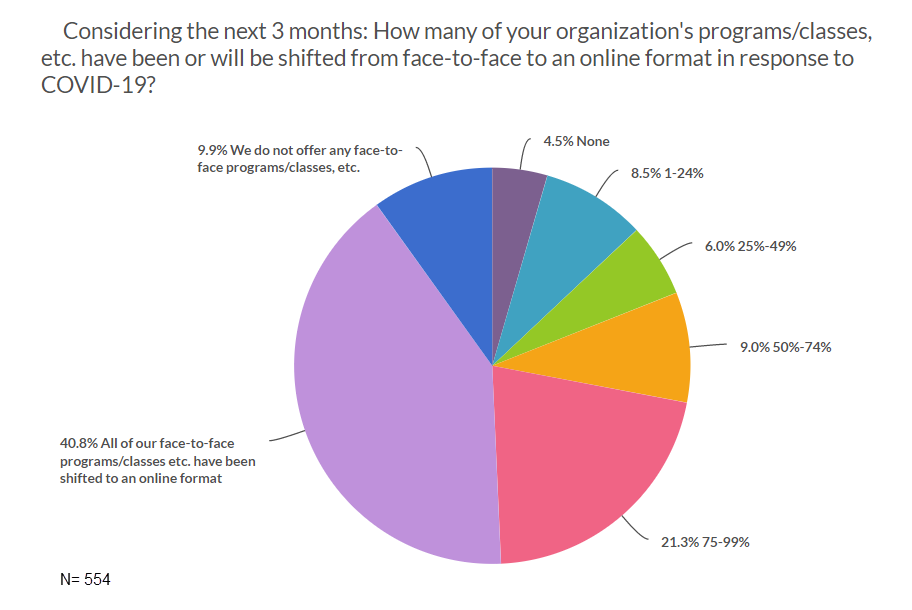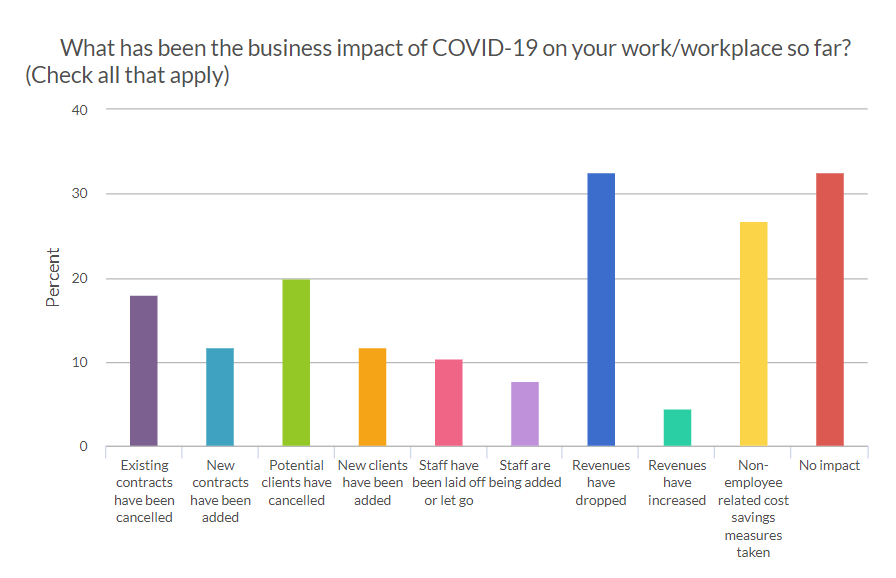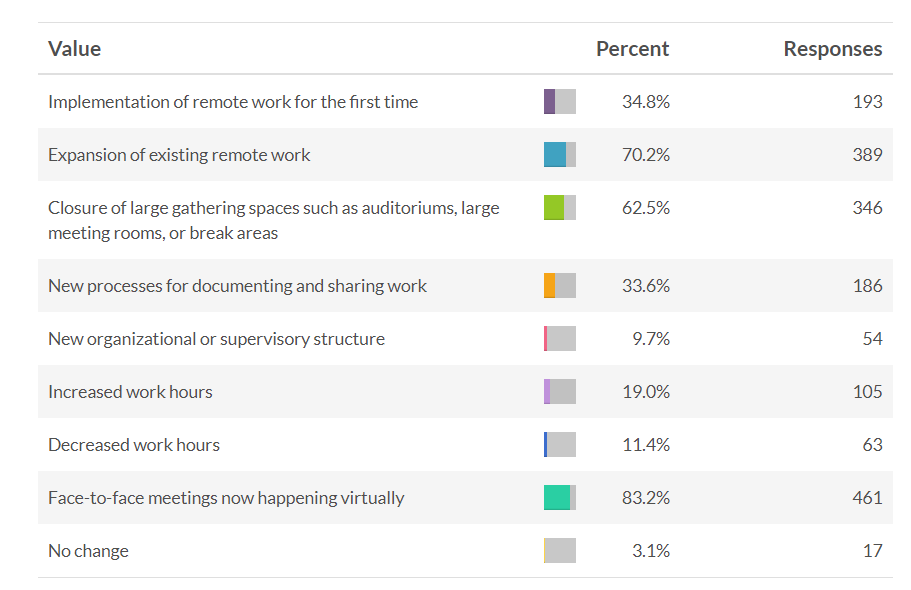In March 2020 as COVID-19 expanded across the globe, The eLearning Guild launched a survey to find out how the pandemic was affecting Guild members in hopes of offering some timely help. Based on comments on various social channels and information from our own colleagues, we took our best guesses about impacts and issues, and included open-text questions to give respondents a chance to mention anything we missed—or just to vent a bit.
Here is a quick overview of the results, 85 percent of which came from respondents in the US and Canada. In the 10 days this survey was open for responses, circumstances around COVID-19 evolved very quickly, with the virus spreading, hotspots emerging, and cities implementing lockdown strategies ranging from recommendations for social distancing to curfews and roadblocks.
Our plan is to offer another survey in a few weeks to see what has shifted or stabilized as we continue to struggle with this pandemic.
Survey results: Shift to online
Not surprisingly, a dramatic impact to L&D practice was the abrupt shift to online delivery of face-to-face courses and other learning experiences, with 86 percent of respondents saying at least one or more events have or are moving to an online format. (Figure 1)

Figure 1: Shift from face-to-face to an online format
This was the most common area addressed in the open-text comments, with respondents asking for help with the process of moving material to a virtual format; those already involved in coaching, providing product training, or otherwise supporting such activities said they found themselves in great demand. One comment: “Just a note of irony: Zoom workshops have been offered for a few years. Miniscule interest until now. Over 300 faculty in workshops [we] provided the past two weeks.”
While some comments expressed concern that the move to online was too fast and would result in mediocre work, others saw a silver lining: After years of encouraging expanded use of eLearning and virtual classroom approaches, they saw the business need come into sharp focus and their ideas get newly-rapid uptake. One commenter hoped the COVID crisis would help move the needle on technology acceptance in their somewhat resistant workforce.
In addition to learning experiences, the shift to virtual approaches had a big impact elsewhere, with 83 percent of respondents saying previous face-to-face meetings are now happening virtually and many others (see “survey results: business practices” below) seeing implementation or expansion of remote work arrangements.
Survey results: Cancellations
- A third of respondents said planned L&D projects scheduled to launch have been cancelled, with 21 percent of those saying this includes five or more projects.
- 359 respondents said one or more conferences or other professional events have been cancelled.
- 228 respondents said workshops and classes they facilitate have been cancelled.
A number of respondents also offered examples of personal events that had been cancelled, such as vacations, graduations, and family trips and excursions, or work-related events they would miss, like the annual company gala.
Survey results: Business impact
A third of respondents said thus far they have experienced no impact, with exactly as many (179) reporting that revenues had already dropped. Several people said they have already been laid off, some with the warning that it may be for three-to-six months or longer. Other respondents, however, have seen an uptick in business, with new clients and contracts being added.
One respondent commented that the survey item did not offer the response “Client has gone out of business”; another said due to slashed budgets they lost their LMS and are scrambling to make do with an unfamiliar open-source product for a workforce of 5,000. ] (Figure 2)

 Figure 2: Business impact of COVID-19
Figure 2: Business impact of COVID-19
Survey results: Business practices
Respondents were asked about ways COVID-19 had affected their business practices. A shift to working and meeting remotely, either for the first time or via expansion of existing practices, was by far the biggest change. (Note that respondents could check all items that applied; some organizations both expanded existing remote work for some workers and implemented it for the first time for others.) Other changes of note: face-to-face meetings are now happening virtually, large public gathering spaces have been closed, and they are engaging in new processes for documenting and sharing work. (Figure 3)

Figure 3: Impact of COVID-19 on business practices
Respondents were given the opportunity to offer additional comments in an open-text format. Many talked of their surprise at how unprepared their organizations were to respond to a crisis. Even as businesses were being ordered to close and employees told to stay home, respondents said HR departments were still ‘working on’ remote work policies and clients were still saying they wanted to wait to implement online learning solutions.
Comments here were particularly focused on the shift to or expansion of remote work. Issues ranged from overwhelmed infrastructure and problems with VPNs and apps to frustrations with overloaded virtual classroom products, the lack of an HR policy on remote work, and communication problems across departments and via vertical channels. One respondent working from home noted that their productivity and work hours had decreased due to the sudden need to provide homeschooling and oversight to their six year old. Otherwise, many commenters spoke about remote work as a positive change, one they hoped would be sustained:
- “The employer gets great productivity because those few divisions that use work-from-home successfully want to keep the privilege.”
- "[It] has raised awareness of how effective remote work can be. We are still accomplishing the job and in some ways better than being in the office."
Comments about problems with the human side of remote work seem to rest more with administrators than with workers, with managers struggling to understand how to oversee remote employees.
Survey results: What do you need help with?
Not surprisingly, the vast proportion of respondents said they need help with moving traditional instruction to an online format. Interests ranged from rapid development and deployment to help with evaluating tools to strategies for determining which experiences were appropriate for delivery via an online format. Check here for the recording of The eLearning Guild’s April 1 Virtual Classroom Online Conference.
Another area of concern was the matter of implementing remote work—from tools and strategies to learning how to supervise remote work. The eLearning Guild is also developing resources to support and concerns around remote work.
Some respondents spoke of the need to support workers and sustain morale through a time of crisis. For example:
“I need to know how to implement morale booster tips and where to get them. Not all our workers can work remotely; those who still need to go to the plant (equipment assembly) may feel at risk, unsupported, forgotten, and may become disengaged regardless of our intensified cleaning and communication efforts. They are the core of what we do and we all depend on them, so we need for them to remain engaged and to feel protected. How can we make sure that’s the case? How can we combat fear?”
Editor's note: Resources to meet these concerns will be offered in Learning Solutions articles and The eLearning Guild's online community support site (Twist curated content, GuildChat, and ad hoc event announcements).
And finally, predictions
“My employer has been fast and aggressive to respond to what we perceive as many months of travel disruption. This is going to change how we do business forever.”
“There has been a culture shift that we are certain will leave us as better communicators and collaborators."
What’s next?
We plan to offer the survey again in a few weeks. It’s assumed much of the rush to move online and establish remote work protocols will have passed, and new areas of impact or concern will have emerged. We hope to be able to help The eLearning Guild community better meet these evolving needs. Meantime: We know this is a difficult time for members of The eLearning Guild community and wish you and your loved ones good health and safety in the coming months.



